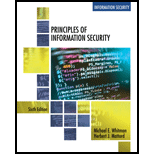
Annualized Rate Occurrence (ARO):
Annualized Rate Occurrence is the estimated frequency at which a given threat is expected to happen.
ARO can be calculated by using the following formula:
Annualized Loss Expectancy (ALE):
Annualized Loss Expectancy is the loss expected from the attack of a specific information asset which has been carried over for a year. It is a product of single loss expectancy and the annualized rate of occurrence.
ALE can be calculated by using the following formula:
Cost-Benefit Analysis (CBA):
- CBA is the study that determines the cost required for protecting an asset.
- It is a process of feasibility which is carried with a formal documentation process. It is also called as economic feasibility study.
- System value is an estimated total cost of the organization in terms of the cost of equipment, and more important, in terms of the cost of information stored in the system.
CBA can be calculated by using the following formula:
Here, the term
Explanation of Solution
Calculate ARO for Programmer mistakes:
Substitute the value of “One year” as “365” and “Frequency of occurrence (One per months)” as “
Hence, the ARO for programmer mistakes is “12 (approximately)”.
Calculate ARO for Loss if intellectual property:
Substitute the value of “One year” as “365” and “Frequency of occurrence (One per 10 years)” as “
Hence, the ARO for Loss if intellectual property is “0.5 (approximately)”.
Calculate ARO for Software Piracy:
Substitute the value of “One year” as “365” and “Frequency of occurrence (One per months)” as “
Hence, the ARO for Software Piracy is “12 (approximately)”.
Calculate ARO for Theft of information (hacker):
Substitute the value of “One year” as “365” and “Frequency of occurrence (One per 6 months)” as “
Hence, the ARO for Theft of information (hacker) is “2 (approximately)”.
Calculate ARO for Theft of information (employee):
Substitute the value of “One year” as “365” and “Frequency of occurrence (One per year)” as “365” in the equation (1).
Hence, the ARO for Theft of Theft of information (employee) is “1 (approximately)”.
Calculate ARO for Web defacement:
Substitute the value of “One year” as “365” and “Frequency of occurrence (One per quarter)” as “
Hence, the ARO for Web defacement is “4 (approximately)”.
Calculate ARO for Theft of equipment:
Substitute the value of “One year” as “365” and “Frequency of occurrence (One per 10 years)” as “
Hence, the ARO for Theft of equipment is “0.5 (approximately)”.
Calculate ARO for Viruses, worms, Trojan Horses:
Substitute the value of “One year” as “365” and “Frequency of occurrence (One per months)” as “
Hence, the ARO for Viruses, worms, Trojan Horses is “12 (approximately)”.
Calculate ARO for Denial-of-service attacks:
Substitute the value of “One year” as “365” and “Frequency of occurrence (One per 6 months)” as “
Hence, the ARO for Denial-of-service attacks is “2 (approximately)”.
Calculate ARO for Earthquake:
Substitute the value of “One year” as “365” and “Frequency of occurrence (One per 20 years)” as “
Hence, the ARO for Earthquake is “0.05 (approximately)”.
Calculate ARO for Food:
Substitute the value of “One year” as “365” and “Frequency of occurrence (One per 10 years)” as “
Hence, the ARO for Food is “0.1 (approximately)”.
Calculate ARO for Fire:
Substitute the value of “One year” as “365” and “Frequency of occurrence (One per 10 years)” as “
Hence, the ARO for Fire is “0.1 (approximately)”.
Calculate ALE for Programmer mistakes:
Substitute the value of “SLE” as “5000” and “ARO” as “12” in the equation (2).
Hence, the ALE for programmer mistakes is “60000”.
Calculate ALE for Loss if intellectual property:
Substitute the value of “SLE” as “75000” and “ARO” as “0.5” in the equation (2).
Hence, the ALE for Loss if intellectual property is “37500”.
Calculate ALE for Software Piracy:
Substitute the value of “SLE” as “500” and “ARO” as “12” in the equation (2).
Hence, the ALE for Software Piracy is “6000”.
Calculate ALE for Theft of information(hacker):
Substitute the value of “SLE” as “2500” and “ARO” as “2” in the equation (2).
Hence, the ALE for Theft of information (hacker)is “5000”.
Calculate ALE for Theft of information (employee)
Substitute the value of “SLE” as “5000” and “ARO” as “1” in the equation (2).
Hence, the ALE for Theft of information (employee) is “5000”.
Calculate ALE for Web defacement:
Substitute the value of “SLE” as “500” and “ARO” as “4” in the equation (2).
Hence, the ALE for Web defacement is “2000”.
Calculate ALE for Theft of equipment:
Substitute the value of “SLE” as “5000” and “ARO” as “0.5” in the equation (2).
Hence, the ALE for Theft of equipment is “2500”.
Calculate ALE for Viruses, worms, Trojan Horses:
Substitute the value of “SLE” as “1500” and “ARO” as “12” in the equation (2).
Hence, the ALE for Viruses, worms, Trojan Horses is “18000”.
Calculate ALE for Denial-of-service attacks:
Substitute the value of “SLE” as “2500” and “ARO” as “2” in the equation (2).
Hence, the ALE for Denial-of-service attacks is “5000”.
Calculate ALE for Earthquake:
Substitute the value of “SLE” as “250000” and “ARO” as “0.05” in the equation (2).
Hence, the ALE for Earthquake is “12500”.
Calculate ALE for Food:
Substitute the value of “SLE” as “50000” and “ARO” as “0.1” in the equation (2).
Hence, the ALE for Food is “5000”.
Calculate ALE for Fire:
Substitute the value of “SLE” as “100000” and “ARO” as “0.1” in the equation (2).
Hence, the ALE for Fire is “10000”.
To calculate CBA for Programmer mistakes:
Substitute the value of “ALE (prior)” as “260000” and “ALE (post)” as “60000” and “ACS” as “20000” in the equation (3).
Hence, the CBA for programmer mistakes is “180000”.
To calculate CBA for Loss if intellectual property:
Substitute the value of “ALE (prior)” as “75000” and “ALE (post)” as “37500” and “ACS” as “15000” in the equation (3).
Hence, the CBA for Loss if intellectual property is “22500”.
To calculate CBA for Software Piracy:
Substitute the value of “ALE (prior)” as “26000” and “ALE (post)” as “6000” and “ACS” as “30000” in the equation (3).
Hence, the CBA for Software Piracy is “-10000”.
To calculate CBA for Theft of information (hacker):
Substitute the value of “ALE (prior)” as “10000” and “ALE (post)” as “5000” and “ACS” as “15000” in the equation (3).
Hence, the CBA for Theft of information (hacker) is “-10000”.
To calculate CBA for Theft of information (employee):
Substitute the value of “ALE (prior)” as “10000” and “ALE (post)” as “5000” and “ACS” as “15000” in the equation (3).
Hence, the CBA for Theft of information (employee) is “-10000”.
To calculate CBA for Web defacement:
Substitute the value of “ALE (prior)” as “6000” and “ALE (post)” as “2000” and “ACS” as “10000” in the equation (3).
Hence, the CBA for Web defacement is “-6000”.
To calculate CBA for Theft of equipment:
Substitute the value of “ALE (prior)” as “5000” and “ALE (post)” as “2500” and “ACS” as “15000” in the equation (3).
Hence, the CBA for Theft of equipment is “-12500”.
To calculate CBA for Viruses, worms, Trojan Horses:
Substitute the value of “ALE (prior)” as “78000” and “ALE (post)” as “18000” and “ACS” as “15000” in the equation (3).
Hence, the CBA for Viruses, worms, Trojan Horses is “45000”.
To calculate CBA for Denial-of-service attacks:
Substitute the value of “ALE (prior)” as “10000” and “ALE (post)” as “5000” and “ACS” as “10000” in the equation (3).
Hence, the CBA for Denial-of-service attacks is “-5000”.
To calculate CBA for Earthquake:
Substitute the value of “ALE (prior)” as “12500” and “ALE (post)” as “12500” and “ACS” as “5000” in the equation (3).
Hence, the CBA for Earthquake is “-5000”.
To calculate CBA for Food:
Substitute the value of “ALE (prior)” as “25000” and “ALE (post)” as “5000” and “ACS” as “10000” in the equation (3).
Hence, the CBA for Food is “10000”.
To calculate CBA for Fire:
Substitute the value of “ALE (prior)” as “50000” and “ALE (post)” as “10000” and “ACS” as “10000” in the equation (3).
Hence, the CBA for Fire is “30000”.
ARO and ALE table for all the threat cost is given below:
| ARO and ALE threats | SLE | ARO | ALE | CBA |
| Programmer mistakes | 5,000 | 12 | 60,000 | 180,000 |
| Loss if intellectual property | 75,000 | 0.5 | 37,500 | 22,500 |
| Software Piracy | 500 | 12 | 6,000 | -10,000 |
| Theft of information(hacker) | 2,500 | 2 | 5,000 | -10,000 |
| Theft of information (employee) | 5,000 | 1 | 5,000 | -10,000 |
| Web defacement | 500 | 4 | 2,000 | -6,000 |
| Theft of equipment | 5,000 | 0.5 | 2,500 | -12,500 |
| Viruses, worms, Trojan Horses | 1,500 | 12 | 18,000 | 45,000 |
| Denial-of-service attacks | 2,500 | 2 | 5,000 | -5000 |
| Earthquake | 250,000 | 0.05 | 12,500 | -5,000 |
| Food | 50,000 | 0.1 | 5,000 | 10,000 |
| Fire | 100,000 | 0.1 | 10,000 | 30,000 |
Reason for changes in values:
Some values have been changed because of the implementation controls which had a positive impact on protection of XYZ’s assets. Thus, reducing the frequency of occurrences. However, the controls did not decrease cost for a single incident because the importance of an asset will stay the same and cost XYZ the same amount of time and money to replace. The costs that are listed are worth when the controls are in their place.
Want to see more full solutions like this?
Chapter 5 Solutions
Principles Of Information Security, Loose-leaf Version
- Obtain the MUX design for the function F(X,Y,Z) = (0,3,4,7) using an off-the-shelf MUX with an active low strobe input (E).arrow_forwardI cannot program smart home automation rules from my device using a computer or phone, and I would like to know how to properly connect devices such as switches and sensors together ? Cisco Packet Tracer 1. Smart Home Automation:o Connect a temperature sensor and a fan to a home gateway.o Configure the home gateway so that the fan is activated when the temperature exceedsa set threshold (e.g., 30°C).2. WiFi Network Configuration:o Set up a wireless LAN with a unique SSID.o Enable WPA2 encryption to secure the WiFi network.o Implement MAC address filtering to allow only specific clients to connect.3. WLC Configuration:o Deploy at least two wireless access points connected to a Wireless LAN Controller(WLC).o Configure the WLC to manage the APs, broadcast the configured SSID, and applyconsistent security settings across all APs.arrow_forwardusing r language for integration theta = integral 0 to infinity (x^4)*e^(-x^2)/2 dx (1) use the density function of standard normal distribution N(0,1) f(x) = 1/sqrt(2pi) * e^(-x^2)/2 -infinity <x<infinity as importance function and obtain an estimate theta 1 for theta set m=100 for the estimate whatt is the estimate theta 1? (2)use the density function of gamma (r=5 λ=1/2)distribution f(x)=λ^r/Γ(r) x^(r-1)e^(-λx) x>=0 as importance function and obtain an estimate theta 2 for theta set m=1000 fir the estimate what is the estimate theta2? (3) use simulation (repeat 1000 times) to estimate the variance of the estimates theta1 and theta 2 which one has smaller variance?arrow_forward
- using r language A continuous random variable X has density function f(x)=1/56(3x^2+4x^3+5x^4).0<=x<=2 (1) secify the density g of the random variable Y you find for the acceptance rejection method. (2) what is the value of c you choose to use for the acceptance rejection method (3) use the acceptance rejection method to generate a random sample of size 1000 from the distribution of X .graph the density histogram of the sample and compare it with the density function f(x)arrow_forwardusing r language a continuous random variable X has density function f(x)=1/4x^3e^-(pi/2)^4,x>=0 derive the probability inverse transformation F^(-1)x where F(x) is the cdf of the random variable Xarrow_forwardusing r language in an accelerated failure test, components are operated under extreme conditions so that a substantial number will fail in a rather short time. in such a test involving two types of microships 600 chips manufactured by an existing process were tested and 125 of them failed then 800 chips manufactured by a new process were tested and 130 of them failed what is the 90%confidence interval for the difference between the proportions of failure for chips manufactured by two processes? using r languagearrow_forward
- I want a picture of the tools and the pictures used Cisco Packet Tracer Smart Home Automation:o Connect a temperature sensor and a fan to a home gateway.o Configure the home gateway so that the fan is activated when the temperature exceedsa set threshold (e.g., 30°C).2. WiFi Network Configuration:o Set up a wireless LAN with a unique SSID.o Enable WPA2 encryption to secure the WiFi network.o Implement MAC address filtering to allow only specific clients to connect.3. WLC Configuration:o Deploy at least two wireless access points connected to a Wireless LAN Controller(WLC).o Configure the WLC to manage the APs, broadcast the configured SSID, and applyconsistent security settings across all APs.arrow_forwardA. What will be printed executing the code above?B. What is the simplest way to set a variable of the class Full_Date to January 26 2020?C. Are there any empty constructors in this class Full_Date?a. If there is(are) in which code line(s)?b. If there is not, how would an empty constructor be? (create the code lines for it)D. Can the command std::cout << d1.m << std::endl; be included after line 28 withoutcausing an error?a. If it can, what will be printed?b. If it cannot, how could this command be fixed?arrow_forwardCisco Packet Tracer Smart Home Automation:o Connect a temperature sensor and a fan to a home gateway.o Configure the home gateway so that the fan is activated when the temperature exceedsa set threshold (e.g., 30°C).2. WiFi Network Configuration:o Set up a wireless LAN with a unique SSID.o Enable WPA2 encryption to secure the WiFi network.o Implement MAC address filtering to allow only specific clients to connect.3. WLC Configuration:o Deploy at least two wireless access points connected to a Wireless LAN Controller(WLC).o Configure the WLC to manage the APs, broadcast the configured SSID, and applyconsistent security settings across all APs.arrow_forward
- Transform the TM below that accepts words over the alphabet Σ= {a, b} with an even number of a's and b's in order that the output tape head is positioned over the first letter of the input, if the word is accepted, and all letters a should be replaced by the letter x. For example, for the input aabbaa the tape and head at the end should be: [x]xbbxx z/z,R b/b,R F ① a/a,R b/b,R a/a, R a/a,R b/b.R K a/a,R L b/b,Rarrow_forwardGiven the C++ code below, create a TM that performs the same operation, i.e., given an input over the alphabet Σ= {a, b} it prints the number of letters b in binary. 1 #include 2 #include 3 4- int main() { std::cout > str; for (char c : str) { if (c == 'b') count++; 5 std::string str; 6 int count = 0; 7 char buffer [1000]; 8 9 10 11- 12 13 14 } 15 16- 17 18 19 } 20 21 22} std::string binary while (count > 0) { binary = std::to_string(count % 2) + binary; count /= 2; std::cout << binary << std::endl; return 0;arrow_forwardConsidering the CFG described below, answer the following questions. Σ = {a, b} • NT = {S} Productions: P1 S⇒aSa P2 P3 SbSb S⇒ a P4 S⇒ b A. List one sequence of productions that can accept the word abaaaba; B. Give three 5-letter words that can be accepted by this CFG; C. Create a Pushdown automaton capable of accepting the language accepted by this CFG.arrow_forward
 Principles of Information Security (MindTap Cours...Computer ScienceISBN:9781337102063Author:Michael E. Whitman, Herbert J. MattordPublisher:Cengage Learning
Principles of Information Security (MindTap Cours...Computer ScienceISBN:9781337102063Author:Michael E. Whitman, Herbert J. MattordPublisher:Cengage Learning Management Of Information SecurityComputer ScienceISBN:9781337405713Author:WHITMAN, Michael.Publisher:Cengage Learning,
Management Of Information SecurityComputer ScienceISBN:9781337405713Author:WHITMAN, Michael.Publisher:Cengage Learning, Principles of Information Systems (MindTap Course...Computer ScienceISBN:9781285867168Author:Ralph Stair, George ReynoldsPublisher:Cengage Learning
Principles of Information Systems (MindTap Course...Computer ScienceISBN:9781285867168Author:Ralph Stair, George ReynoldsPublisher:Cengage Learning Information Technology Project ManagementComputer ScienceISBN:9781337101356Author:Kathy SchwalbePublisher:Cengage LearningCOMPREHENSIVE MICROSOFT OFFICE 365 EXCEComputer ScienceISBN:9780357392676Author:FREUND, StevenPublisher:CENGAGE L
Information Technology Project ManagementComputer ScienceISBN:9781337101356Author:Kathy SchwalbePublisher:Cengage LearningCOMPREHENSIVE MICROSOFT OFFICE 365 EXCEComputer ScienceISBN:9780357392676Author:FREUND, StevenPublisher:CENGAGE L Principles of Information Systems (MindTap Course...Computer ScienceISBN:9781305971776Author:Ralph Stair, George ReynoldsPublisher:Cengage Learning
Principles of Information Systems (MindTap Course...Computer ScienceISBN:9781305971776Author:Ralph Stair, George ReynoldsPublisher:Cengage Learning





